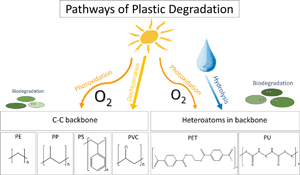Bisphenol A, phtalates, PCBs and other organic pollutants often embedded in plastics have been under the spotlight for a while. However, very few people have studied the degradation pathways of oceanic plastic debris. An article recently published in Environmental Science: Processes & Impacts critically reviews this topic.
Plastics have been widely used since the 1940s. In 2013, global plastic production reached 300 mega tonnes (50 times the Great Pyramid of Giza). We discard most of the plastic right away, within 3 years of its production. Yet, it is engineered to last for hundreds or even thousands of years. Thus, tonnes of plastic debris accumulate in the environment.
Scientists are especially concerned about plastic debris accumulating in the oceans. By 2050, 99% of all seabirds will have ingested, at least, one small piece of plastic. Nowadays, plastics represent more than 60% of all the floating debris in the oceans. All these pieces of plastic may release organic pollutants to the sea, either additives or adsorbed substance. Despite their high stability, plastics might also decompose by the action of different factors, releasing potentially dangerous chemicals.

Polymer degradation is, technically, a decline of its original properties. Usually it can be easily spotted by observing the colour changes or cracking of the surface. Small plastic particles decompose faster, due to their higher surface to volume ratio. Depending on the structure of their backbone, plastics can degrade in very different ways. Plastic with carbon-carbon backbones (i.e. PE, PP, PS, PVC) often suffer abiotic decomposition, usually initiated by UV radiation or thermal processes. Plastics with heteroatoms in their backbones (i.e. PU, PET) may also suffer abiotic decomposition, but in this case hydrolysis is the most common process. Furthermore, enzymes may also break amide and ester bonds, therefore these plastics are also exposed to biodegradation.
If you want to better understand the different degradation pathways, I strongly recommend that you go over this Environmental Science: Processes & Impacts Critical Review where all the mechanisms are carefully examined and explained.
Click on the link below to read the full article for free*:
Pathways for degradation of plastic polymers floating in the marine environment
Berit Gewert, Merle M. Plassmann and Matthew MacLeod
Environ. Sci: Processes Impacts, 2015, 17, 1513-1521
DOI: 10.1039/C5EM00207A
—————-
Fernando Gomollón-Bel is a PhD Student at the ISQCH (CSIC–University of Zaragoza). His research focuses on asymmetric organic synthesis using sugars as chiral-pool starting materials towards the production of fungical transglycosidase inhibitors.
—————-
* Access is free through a registered RSC account.











